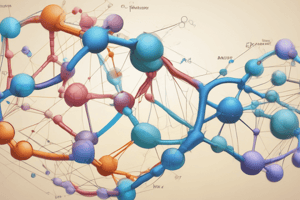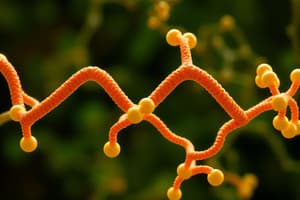Podcast
Questions and Answers
What is the major site of nucleotide biosynthesis?
What is the major site of nucleotide biosynthesis?
- Liver (correct)
- Kidney
- Pancreas
- Brain
What is the starting substrate for purine nucleotide synthesis?
What is the starting substrate for purine nucleotide synthesis?
- Ribose-5 phosphate
- 5-phosphoribosyl-1-pyrophosphate (PRPP) (correct)
- Glycine
- Glutamine
What is the end product of the de novo purine synthesis pathway?
What is the end product of the de novo purine synthesis pathway?
- Inosine diphosphate (IDP)
- Adenosine monophosphate (AMP)
- Guanosine monophosphate (GMP)
- Inosine monophosphate (IMP) (correct)
What is the mechanism of action of trimethoprim on bacterial purine synthesis?
What is the mechanism of action of trimethoprim on bacterial purine synthesis?
What is the mechanism of action of sulfonamides/sulfa drugs on bacterial purine synthesis?
What is the mechanism of action of sulfonamides/sulfa drugs on bacterial purine synthesis?
What is the mechanism of action of methotrexate on purine synthesis?
What is the mechanism of action of methotrexate on purine synthesis?
Which enzyme is responsible for converting IMP to XMP in the de novo purine nucleotide synthesis pathway?
Which enzyme is responsible for converting IMP to XMP in the de novo purine nucleotide synthesis pathway?
What is the function of thymidylate synthase in nucleotide metabolism?
What is the function of thymidylate synthase in nucleotide metabolism?
Which of the following disorders is associated with a deficiency in hypoxanthine guanine phosphoribosyl transferase (HGPRT)?
Which of the following disorders is associated with a deficiency in hypoxanthine guanine phosphoribosyl transferase (HGPRT)?
What is the role of dihydrofolate reductase in nucleotide metabolism?
What is the role of dihydrofolate reductase in nucleotide metabolism?
Which of the following nucleotides is involved in the transmission of free energy in the cell?
Which of the following nucleotides is involved in the transmission of free energy in the cell?
What is the function of ribonucleotide reductase in nucleotide metabolism?
What is the function of ribonucleotide reductase in nucleotide metabolism?
What is the rate-limiting step in the de novo pyrimidine synthesis?
What is the rate-limiting step in the de novo pyrimidine synthesis?
Which of the following is NOT a product of de novo pyrimidine synthesis?
Which of the following is NOT a product of de novo pyrimidine synthesis?
What is the function of tetrahydrofolate in nucleotide synthesis?
What is the function of tetrahydrofolate in nucleotide synthesis?
Which of the following is a symptom of orotic aciduria?
Which of the following is a symptom of orotic aciduria?
What is the function of PRPP in de novo pyrimidine synthesis?
What is the function of PRPP in de novo pyrimidine synthesis?
What is the treatment for orotic aciduria?
What is the treatment for orotic aciduria?
Study Notes
Nucleotide Synthesis Overview
- Nucleotides are synthesized as ribonucleoside monophosphates (NMPs)
- Starting substrate for purine nucleotide synthesis is 5-phosphoribosyl-1-pyrophosphate (PRPP)
- PRPP is synthesized from ribose-5 phosphate and requires ATP, Mg2+, and is activated by free Pi
- End-product inhibition is a recurring theme in nucleotide synthesis
De Novo Pathway: Purine Synthesis
- Uses 5-phosphoribosyl 1-pyrophosphate (PRPP) as the starting "scaffold"
- The purine ring is built by additions of carbons and nitrogens from various sources including aspartate, glycine, glutamine, CO2, and N10-formyltetrahydrofolate
- The end product is inosine monophosphate (IMP)
Clinical Correlates
- Antibiotics that target folic acid metabolism:
- Sulfonamides/sulfa drugs competitively inhibit bacterial synthesis of folic acid and slow down purine synthesis
- Trimethoprim inhibits the reduction of dihydrofolate to tetrahydrofolate, which slows down purine synthesis
- Folic acid analogs:
- Methotrexate is an analog of dihydrofolate
Nucleotide Functions
- Nucleotides have three components: nitrogen-base derivatives, pentose, and phosphates
- Functions:
- Monomeric units of DNA and RNA
- Provide free energy for chemical reactions (ATP and GTP)
- Components of coenzymes (Flavin adenine dinucleotide, Nicotinamide adenine dinucleotide, coenzyme A)
De Novo Pyrimidine Synthesis
- Purpose: Synthesis of a pyrimidine ring from scratch through the additions of carbons and nitrogens from aspartate, glutamine, and CO2
- Then it is added to ribose-5-phosphate (from PRPP)
- The end product is UMP, an important intermediate is orotic acid
- UMP is modified to generate UTP and CTP for RNA synthesis and dCTP and dTTP for DNA synthesis
- Key steps:
- The rate-limiting step is the formation of carbamoyl phosphate by carbamoyl phosphate synthetase II (CPSII)
- Another important step is the generation of (d)TMP from dUMP by thymidylate synthase, which is the rate-limiting step for DNA synthesis and requires tetrahydrofolate
- Hormonal control: N/A
- Allosteric/local control: CPSII is activated by PRPP and inhibited by UTP
- Deficiencies/diseases: Orotic aciduria with high orotic acid in urine, failure to thrive, and anemia
Studying That Suits You
Use AI to generate personalized quizzes and flashcards to suit your learning preferences.
Description
Test your knowledge on the biosynthesis of nucleotides, including the de novo and salvage pathways, and the role of the liver in this process.




